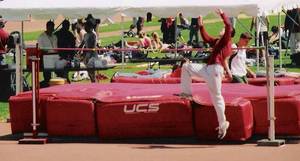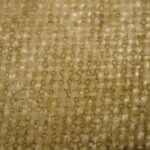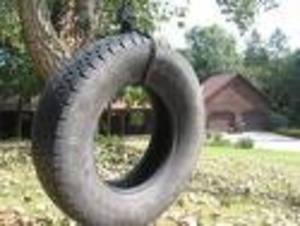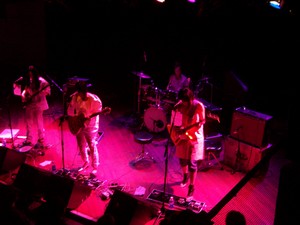Here are a few exercises that will help your high jump technique. If you are performing an exercise such as a box jump, it is a good idea not to use the fiberglass high jump bar. You will be falling from greater heights, and if you knock the bar off and land on it, it will be extremely painful. Try to get your coach to invest in what is called a “bungee cord”, a springy rubber strand that stretches between the standards. It isn’t knocked off as easily as a bar and won’t hurt if you land on it. Above all, BE CAREFUL. Never do any of these exercises alone because you can injure yourself if they are performed improperly. It is necessary to have someone nearby that can tell you if you are in danger of doing something improperly.
Box Jumps
Box Jumps are designed to give you more time in the air to work on the arch phase of your jump. Take a sturdy wooden or metal box (they often have them in gyms) about two to three feet in height. Place the box in front of the high jump mats and adjust the height of the standards so that the bungee cord is about level with your upper back (while you’re standing on the box) to start. Next, stand on the box with your back turned from the high jump pit, about a foot away from the bungee cord. Then, lower your hips and bend your knees to gather strength. You won’t have the benefit of an approach run to give you momentum, so you’re going to have to rely solely on leg and arm strength. Now, drive upward with your legs and arms so that you become airborne, then work on your arch once you reach the peak of the jump. Being off the ground to begin with will give you more time in the air and will give you a chance to better practice your arch without expending a lot of energy on a full approach. Be careful how you land on the mats. You are falling from higher up, so rotation might cause you to land uncomfortably on your neck instead of your shoulders. To avoid this, try to do a reverse somersault once you feel your body strike the mats. This will help to cushion the impact and save your neck some grief.
Convex Box Jumps
A convex box is a box that is shaped like a contact lens or an upside-down cereal bowl. These kinds of boxes will allow your foot to roll from a heel-strike position, as well as allow for more of a knee-drive to increase power. The center convex box is placed exactly where your last step would land on an approach run. Unlike the box jumps previously described, the convex box will allow for you to take an approach run. However, you do not want to take a full approach at full speed, for this can pose a risk of injury if your foot strikes the box incorrectly. Instead, do an abbreviated two or three stride approach run. Since you can get more power and therefore more lift off of this box, you can raise the standards and bungee cord to a higher height for practice (usually up to a foot over your highest normal high jump). This will give you more air time and therefore more time to work on your arch in midair.
Mousetraps
Mousetraps, unlike the other exercises are relatively harmless to perform and carry minimal risk of injury. Climb onto the high jump mats and lay on your back. Next, you want to push your abdominals upward to the sky and support yourself using your legs and arms underneath you. You should look like you’re performing an arch over the bar, except not in midair. Hold this position for a few seconds, and then quickly contract your abdominals, tucking your chin into your chest. Throw your arms forward and bring your legs toward your chest, just like you would in a midair jump. The purpose of a mousetrap is to work on your quick conversion from arch to final phase. It is called a mousetrap because of the “snapping” movement you are doing, like the jaws of a bear or mouse trap.
Those are three exercises you can perform in order to improve your placement and technique over the bar. I have found all to be beneficial, and easier to do than expending too much energy on full jumps during practice.






